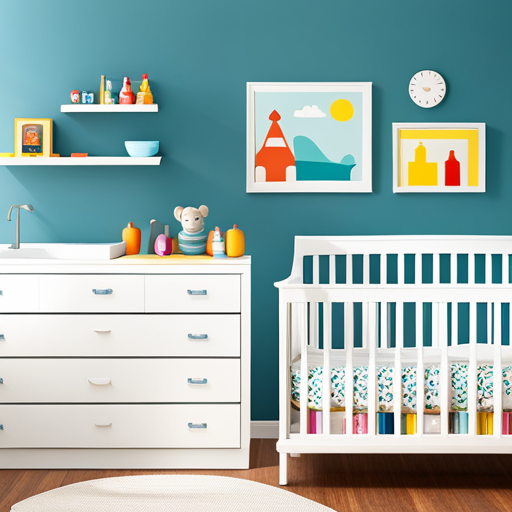Baby’s Routine Checklists
Are you feeling like a tightrope walker, trying to balance all the demands of taking care of your little one?
Well, fear not! Just like a well-orchestrated symphony, a baby’s routine checklist can be your guiding sheet music. With its gentle guidance, you can navigate through the day, ensuring that every essential task is completed with ease and efficiency.
From feeding and diaper changes to playtime and naps, this checklist will help you stay on top of it all, giving you the peace of mind you deserve. So, get ready to conduct your baby’s daily routine like a maestro, and let this checklist be your trusty baton.
Let’s dive in and discover the secrets to a harmonious day with your little one.
Key Takeaways
- Baby’s routine checklists provide structure and consistency for their growth and development.
- It is important to avoid being too rigid with the schedule and overpacking the checklist with too many activities or tasks.
- Establishing a consistent feeding schedule, paying attention to sleeping patterns, and creating a relaxing bedtime routine are essential tasks for a baby’s daily routine.
- Must-have items for a baby’s schedule include a crib or bassinet, swaddle blankets, bottles and bottle brush, burp cloths, diapers, wipes, and a well-stocked diaper bag.
Importance of Baby’s Routine Checklists
To ensure the well-being and development of your baby, following a routine checklist is of utmost importance. A baby’s routine checklist provides structure and consistency, which are crucial for their overall growth and development. By following a checklist, you create a predictable and stable environment that helps your baby feel secure and nurtured.
One of the main benefits of following a baby’s routine checklist is that it promotes healthy sleep patterns. A consistent bedtime routine, such as bathing, reading a bedtime story, and cuddling, helps signal to your baby that it’s time to sleep. This can lead to more restful nights for both you and your little one.
Another advantage of having a routine checklist is that it helps establish regular feeding schedules. Babies thrive on routine, and having set meal times can ensure that they’re getting the nutrition they need throughout the day. It also helps you identify any feeding issues or concerns early on.
However, when creating a baby’s routine checklist, there are some common mistakes to avoid. One mistake is being too rigid with the schedule. While having a routine is important, it’s also essential to be flexible and adapt to your baby’s changing needs. Remember, each baby is unique and may require slight adjustments to their routine.
Another mistake is overpacking the checklist with too many activities or tasks. Keep it simple and focus on the essentials, such as feeding, sleeping, playtime, and diaper changes. Trying to fit too much into the day can overwhelm both you and your baby.
Essential Tasks for Baby’s Daily Routine
Complete essential tasks for your baby’s daily routine to ensure their well-being and development.
A consistent and structured routine can provide stability and comfort for your little one.
Let’s start with the daily feeding schedule. Babies thrive on regular meals, so establish set times for breakfast, lunch, dinner, and snacks. This will help regulate their appetite and promote healthy eating habits.
Additionally, pay attention to your baby’s sleeping patterns. Establish a consistent sleep schedule and create a relaxing bedtime routine to help them wind down and prepare for a restful night’s sleep. This can include activities like a warm bath, soothing lullabies, or reading a bedtime story. Adequate sleep is crucial for your baby’s growth and development. Remember to create a peaceful environment conducive to sleep, such as a dark and quiet room.
Must-Have Items for Baby’s Schedule
Establishing a consistent routine for your baby’s schedule requires having essential items on hand. To help you create a smooth and organized baby’s sleep schedule and feeding schedule, here are some must-have items that will make your life easier:
-
Crib or Bassinet: A safe and comfortable sleeping space is essential for your baby’s sleep routine. Invest in a sturdy crib or a cozy bassinet that meets all safety standards.
-
Swaddle Blankets: Swaddling can help your baby feel secure and promote better sleep. Stock up on soft and breathable swaddle blankets to keep your little one snug and calm during naptime.
-
Bottles and Bottle Brush: If you’re bottle-feeding, having a good supply of bottles is essential. Opt for bottles with slow-flow nipples that mimic breastfeeding. Don’t forget to get a bottle brush for easy cleaning.
-
Burp Cloths: Babies can be messy eaters, so having plenty of burp cloths on hand is a must. These soft and absorbent cloths will protect your clothes and furniture during feeding time.
Tips for Creating a Effective Baby’s Routine Checklist
Create an effective baby’s routine checklist by incorporating essential tasks and prioritizing consistency.
Creating a schedule for your baby can help provide structure and stability, making it easier for both you and your little one to navigate through the day.
To start, organize tasks based on their importance and frequency. Begin with the essentials such as feeding, diaper changes, nap times, and playtime. These activities should be the foundation of your checklist, as they’re crucial for your baby’s well-being.
Next, consider adding other tasks such as bath time, tummy time, and storytime to promote development and bonding.
It’s important to remember that babies thrive on routine and predictability, so try to stick to the same schedule every day.
Keep your checklist simple and easy to follow, using clear and concise language. You can use a physical checklist or a digital one, whichever works best for you.
As your baby grows and develops, you may need to adjust the schedule accordingly.
Examples of Baby’s Routine Checklists
Creating a routine for your baby is essential for their overall well-being and development. Here are some examples of a baby’s routine checklist that can help you establish a consistent schedule for your little one:
-
Baby’s feeding schedule: Plan regular feeding times for your baby, ensuring they’re getting the right nutrition and staying hydrated. Include both breastfeeding or bottle-feeding sessions, and gradually introduce solid foods as they grow.
-
Baby’s sleep routine: Set a consistent bedtime and naptime routine for your baby. This can include activities like bath time, reading a book, or singing a lullaby. Create a calming environment in their nursery, with dimmed lights and a comfortable sleep space.
-
Playtime and interactive activities: Schedule regular playtime sessions to stimulate your baby’s senses and encourage their development. This can include tummy time, playing with toys, or singing and dancing together.
-
Daily care routine: Establish a checklist for daily care activities such as diaper changes, bathing, and dressing your baby. This will help you ensure that all their basic needs are met consistently.
Frequently Asked Questions
How Often Should I Update My Baby’s Routine Checklist?
To ensure your baby’s routine checklist is up to date, review and update it regularly. This helps you stay organized and ensures you are meeting your baby’s changing needs. Keep track of feeding, sleeping, and playtime schedules for a smoother daily routine.
What Are Some Common Mistakes to Avoid When Creating a Baby’s Routine Checklist?
When creating a baby’s routine checklist, it’s important to avoid common mistakes that can disrupt consistency. By staying mindful of these errors, you can ensure a smoother and more effective routine for your little one.
Can a Baby’s Routine Checklist Help With Sleep Training?
A baby’s routine checklist can be a valuable tool for sleep training. By establishing a consistent schedule and incorporating sleep cues, you can help your baby develop healthy sleep habits and promote better rest for both of you.
Are There Any Recommended Apps or Tools for Creating and Managing a Baby’s Routine Checklist?
You’ll love the simplicity and convenience of recommended apps and tools for managing and creating your baby’s routine checklist. Stay organized and ensure a smooth day for your little one.
How Can I Involve Other Caregivers, Such as Grandparents or Babysitters, in Following the Baby’s Routine Checklist?
To involve grandparents or babysitters in following the baby’s routine checklist, start by explaining the importance of the routine and its benefits. Share the checklist with them and provide clear instructions and expectations. Regular communication and updates will ensure everyone stays on track.
Conclusion
Creating a routine checklist for your baby is like building a strong foundation for their future.
Just like how a well-constructed house provides stability, a well-planned routine gives your little one a sense of security and structure.
By following essential tasks and having the right items on hand, you ensure that your baby’s day is filled with comfort and care.
So, grab that checklist, put on your superhero cape, and embark on this wonderful journey of nurturing your precious bundle of joy!






